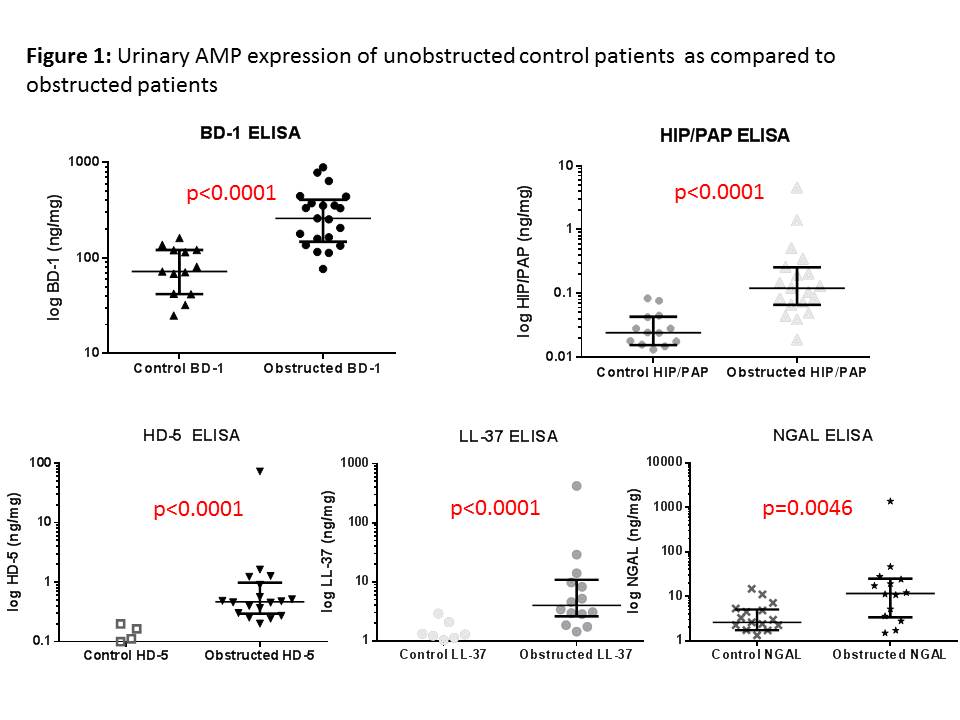Urinary Antimicrobial Peptides are Novel Biomarkers of Obstructive Uropathy
Sudipti Gupta, PhD, Janae Preece, MD, Rollin Li, MS, Molly Fuchs, MD, Seth Alpert, MD, Daniel Dajusta, MD, Daryl Mcleod, MD, MPH, Venkata R. Jayanthi, MD, Brian Becknell, MD, PhD, Christina Ching, MD.
Nationwide Children's Hospital, Columbus, OH, USA.
BACKGROUND:
Antimicrobial peptides (AMPs) exert bactericidal and bacteriostatic activity to promote urinary tract sterility. Mounting evidence supports roles for AMPs in noninfectious conditions, potentially reflecting a broader function during urothelial adaptation and regeneration in the face of injury. Here, we evaluated urinary AMP expression in patients with obstructive uropathy.
METHODS:
Urine was collected from pediatric patients (≤18 years old) undergoing surgical decompression of an obstructed urinary unit due to ureteropelvic or ureterovesical junction obstruction according to an IRB-approved protocol. As controls, urine samples were obtained from children in a general nephrology clinic without evidence of obstruction or UTI based on imaging and urinalysis. Enzyme-linked immunosorbent assays were run to detect beta defensin 1 (BD-1), human alpha defensin 5 (HD-5), hepatocarcinoma-intestine-pancreas/pancreatitis-associated protein (HIP/PAP), LL-37, and NGAL. AMP levels were normalized to urine creatinine. Results were analyzed with Mann-Whitney U test using Graphpad software. A p-value of <0.05 was considered significant.
RESULTS:
21 obstructed samples were obtained: 15 at time of pyeloplasty, 3 at time of ureteroureterostomy, 2 at time of decompressing nephrostomy tube placement, and 1 at time of ureteral reimplant. Urine was taken from the bladder of all patients. 2 patients had functionally solitary kidneys and 16 were male. The mean patient age was 5.4 years old (median 4.3 years old; range 3.6 months to 18.4 years). 17 control urines were obtained for comparison of which 11 patients were male. There were significantly higher urine levels of all AMPs evaluated in obstruction at time of intervention as compared to unobstructed, uninfected controls: BD-1 (p<0.0001), HD-5 (p<0.0001), HIP/PAP (p<0.0001), NGAL (p=0.0046), and LL-37 (p<0.0001) (Figure 1). HIP/PAP levels significantly decreased after surgical decompression as compared to their expression with obstruction (p=0.0059) at a mean postoperative follow-up of 6.3 months (range 2.5-10.5 months) (Figure 2). A decrease in HD-5, NGAL, and LL-37 after surgical decompression approached but did not reach statistical significance.
CONCLUSIONS:
We demonstrate that AMPs may serve as biomarkers of obstructive uropathy and may enable postoperative monitoring. These observations provide a rationale for prospective studies comparing serial urine AMP levels with current modalities for diagnosing obstruction (i.e., serial imaging and in certain cases laboratory monitoring). 

Back to 2016 Fall Congress
